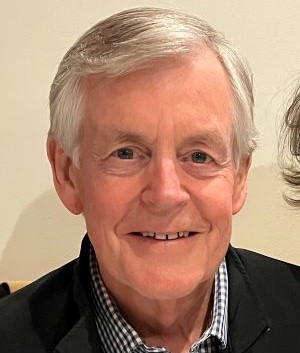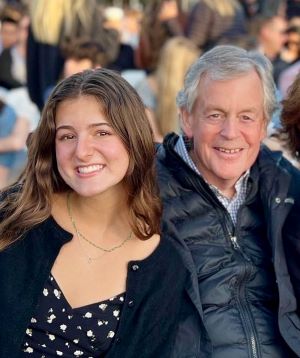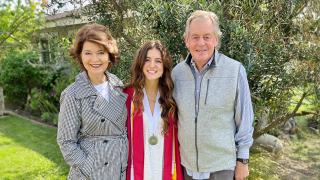
Cancer patients often experience the lowest points in their lives before hope slowly begins to emerge.
For 70-year-old Bob Shank, the lowest of the lows and highest of highs happened within minutes of each other.
A deeply religious man, Shank is the founder of The Master’s Program, a unique nonprofit that helps corporate leaders achieve a higher calling by discovering a lifestyle of “current success and eternal significance,” moving past “what you’re paid for” to “what you’re made for.”
Shank himself was made for action. Strong, intelligent and athletic, he excelled at school sports as well as academics — he was class president and valedictorian. After college, he joined the family’s mechanical contracting business, rose to the top, then sold it. He has focused on his spiritual, nonprofit work ever since.
He’s maintained his fitness all along, running some 40 miles a week, watching his diet and stressing preventive health care. To his children and grandchildren, he was the rock they all admired and aspired to emulate.
So it was a shock when, in late 2021, Shank began to slow down. His weight dropped. He was taking falls too often. One foot began to drag. By early 2022, he was concerned enough to speak to his doctor, thinking he might have a case of long COVID.
Tests spotted more than a dozen abnormalities in Shank’s blood. Alarmed, he consulted a specialist, who dropped a bombshell. “He said I had leukemia,” he recalled, “and that I had to get to the hospital ASAP.”
The news shook the family.
“He was the strongest of all of us,” said granddaughter Avery Krusiewicz. “I didn’t believe it. He was so prominent — I couldn’t imagine life without him.”
Shank saw his diagnosis as a call to action. “Sure, it was disruptive,” he said. “But I did not go into pity mode. I went into proactive mode, seeking a path forward. I know a lot of doctors. They all pointed me to City of Hope.”
His arrival at City of Hope was dramatic.
Shank had become quite ill, suffering from pneumonia and anemia. He couldn’t breathe. His local hospital spent four days stabilizing him before he was delivered by ambulance to City of Hope in the middle of the night.
The drama had just begun.
CML Progresses to Secondary AML
“His disease was rapidly progressing,” recalled Haris Ali, M.D., associate professor in the Division of Leukemia, Department of Hematology & Hematopoietic Cell Transplantation. Originally diagnosed with slow-growing chronic myeloid leukemia (CML), Shank’s condition had deteriorated into secondary acute myeloid leukemia (AML), which is more dangerous and tougher to treat.
Worse, genetic testing showed Shank had a rare mutation in his TP53 gene. TP53 prevents tumors from forming by regulating DNA repair. If the gene is damaged, the risk of cancer is much higher, and the outlook is grim. “Bad prognosis, poor response to treatment and poor survival rates,” Ali summarized.
But, for now, Ali withheld the TP53 details from his patient. In retrospect, Shank agrees with that decision. “There was nothing I could do about it, so he didn’t want to burden me with it,” he said. “In fact, I’m grateful to him for that. I trusted his wisdom.”
He’d noticed that wisdom at their very first meeting.
Ali’s “reputation preceded him,” said Shank. “I found him to be professional, informed, respectful. Just what I needed.”
What Shank also needed, and right away, was a plan. Ali determined that his patient’s only chance would require aggressive chemotherapy to clear the way for a stem cell transplant. Ali was hopeful that, even with the TP53 mutation, Shank would respond to the chemotherapy so the transplant could proceed.
Shank called on his friends and his faith for help.
“I had 30,000 people praying for me,” he said, referring to both his professional network and his many supporters on the Caring Bridge website. “I knew that by Christmas I would either be in heaven or I would be healed.” He insists he was OK with either outcome.
He also points to his biggest booster, who was right beside him throughout.
“I had the benefit of a 52-year partnership with my wife Cheri. She was always there, part of every appointment, taking notes” and handling all the details. “It allowed me to keep my focus on the next phase.”
By mid-March of 2022, Shank had undergone multiple rounds of chemo, which included venetoclax, a drug developed in clinical trials at City of Hope. (“It’s another advantage of being here,” said Ali. “We are at the forefront of cutting-edge treatments.”) The drugs did their job, putting Shank into remission. He could now receive a transplant. But could a donor be found?
An international search for a proper match came up empty. Profoundly disappointed, Shank suddenly found himself back in the hospital, his immune system destroyed by chemotherapy, 60 pounds lighter and dealing with a serious bedsore which, if it became infected, could kill him in his immunocompromised state. He feared he had very little time left.
“This was the low point of the whole process,” he remembered.
Seeking a Stem Cell Donor

But doctors had also tested Shank’s children and grandchildren. One grandson was found to have six of 10 possible markers, enough for a half or “haplo” match. But then his granddaughter spoke up.
“I said, ‘Why did you test the men and not me?’” said Avery, who was 17 at the time. There were several reasons. Transplants tend to work best with donors over 18, preferably male if the recipient is male as well. Also, there are ethical concerns. A minor cannot give legal consent on her own. Strict guidelines must be followed. Parent, child and patient must all agree. A strong relationship between donor and recipient should exist. Risk to the young donor should be minimal, and she must be a better match than all the tested adults.
Avery and her stem cells checked all those boxes, and more. City of Hope’s donor selection committee — a unique panel comprised of hematologists, geneticists, nurses and technicians — made its decision. “We chose the granddaughter over the grandson,” explained Ali, “because she had better KIR typing, which translates into better immune response to the leukemia” in the recipient. (KIR typing refers to an analysis of a person’s “natural killer” immune cells.)
“I was dumbfounded!” Avery recalled. “And I was honored.”
Shank couldn’t believe his good fortune, coming so quickly after such discouraging news. “Within three minutes,” he marveled, “I went from my lowest point to a place of hope. At the weakest moment of my human experience, I was able to stumble onto the best-case scenario.”
Shank’s transplant went remarkably well, thanks to some key assists. Avery settled into the pediatric unit, where she was cared for daily by a child life specialist. Shank calls Avery “the source of my biological ‘rebirth.’”
He was particularly touched when the nurse who brought him Avery’s stem cells for the transplant asked if she could pray for him and his wife before beginning the procedure. “It was very meaningful for us, to say the least,” he said. He continued to heap praise upon the nurses who helped him through his treatment:
“The care community who brought me through my leukemia treatment and ultimate remission had great physicians who carried the ball, but the team of nurses, nurse practitioners and physician assistants were alongside us every step of the way. Through 11 weeks of inpatient care, the 24-hour attention I received from these amazing care professionals made all the difference.”
“He handled it all like a champ,” Ali said, adding that within 17 days, the transplanted cells had engrafted — in some patients it can take as long as six weeks. On Day 19, Shank was discharged, with no evidence of cancer.
Even more surprising, Shank’s TP53 mutation has miraculously disappeared, an exceedingly rare occurrence. “Apparently, it was the leukemia that first generated the mutation,” explained Ali. “The chemo got rid of it, and the transplant consolidated it.”
Shank says Ali was so overjoyed by that news “he was almost doing handstands when he told me!”
Two years post-transplant, Shank is healthy, happy and someone who no longer sweats the small stuff. “For me,” he says, “If you’ve experienced the worst-case scenario, it’s hard to get worked up over those other things.”
Ali is delighted for his star patient.
“He’s a high achiever with high expectations, very committed to doing very well. And he’s an extremely pleasant person. He and his wife are the sweetest people you can meet.”
And attitude matters, Ali insists.
“Always remain hopeful. That’s key to the best outcomes.”
Main image, left to right: Bob Shank's wife Cheri, Shank, and granddaughter and stem cell donor Avery Krusiewicz.
